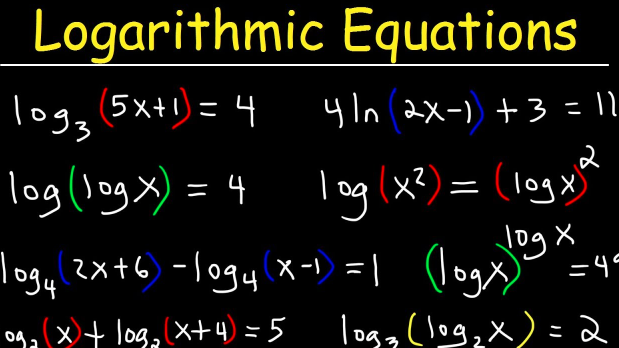How to Solve Logarithmic Equations for x

Solving logarithmic equations is a critical skill in algebra and calculus. These types of problems often emerge in various real-life fields such as science, engineering, economics, and information technology. If you’re learning mathematics or preparing for standardized exams, knowing how to solve logarithmic equations for x is essential.
In this article, we’ll explore the step-by-step methods, key concepts, rules, and different types of problems associated with logarithmic equations that involve solving for the variable x.
What Is a Logarithmic Equation?
A logarithmic equation is one that includes a logarithm—a mathematical operation that is the inverse of exponentiation. A basic logarithmic expression looks like:
log_b(x) = y
When we talk about solving a logarithmic equation for x, we are aiming to isolate the variable x, which is often inside the logarithmic function.
Core Logarithmic Properties
Before attempting to solve logarithmic equations, it’s necessary to understand a few core logarithmic identities and rules:
- Product Rule:
log_b(MN) = log_b(M) + log_b(N) - Quotient Rule:
log_b(M/N) = log_b(M) – log_b(N) - Power Rule:
log_b(M^p) = p × log_b(M) - Change of Base Formula:
log_b(x) = log_k(x) / log_k(b) (where k is any positive base) - Inverse Property:
log_b(b^x) = x and b^(log_b(x)) = x
Understanding these rules allows us to manipulate and simplify logarithmic equations so that we can solve for x effectively.
Step-by-Step Process to Solve for x
Solving a logarithmic equation for x typically involves these basic steps:
- Isolate the logarithmic term(s).
- Simplify using logarithmic properties.
- Convert the logarithmic equation into exponential form.
- Solve the resulting algebraic equation.
- Check for extraneous solutions.
Now, let’s examine different examples to understand these steps better.
Example 1: Single Logarithmic Term
log₂(x) = 4
Step 1: Convert to exponential form
x = 2^4
Step 2: Solve
x = 16
Step 3: Check
Example 2: Logarithmic Equation with Coefficient
3·log₁₀(x) = 6
Step 1: Divide both sides by 3
log₁₀(x) = 2
Step 2: Convert to exponential form
x = 10² = 100
Step 3: Check
log₁₀(100) = 2 → Valid
See also: How Design Thinking Can Transform Your Business in 2025
Example 3: Logarithmic Equation with Addition
log₅(x) + log₅(x – 4) = 2
Step 1: Use the product rule
log₅(x(x – 4)) = 2
Step 2: Simplify
log₅(x² – 4x) = 2
Step 3: Convert to exponential form
x² – 4x = 25
Step 4: Solve
x² – 4x – 25 = 0
Use the quadratic formula:
x = [4 ± √(16 + 100)] / 2 = [4 ± √116] / 2
x ≈ 8.38 or -2.38
Step 5: Check
x = 8.38 → Both x and x – 4 are positive → Valid
x = -2.38 → Argument of log becomes negative → Invalid
So, only x ≈ 8.38 is a valid solution.
Example 4: Logs on Both Sides
log₃(2x + 1) = log₃(x + 5)
Step 1: Since the logs have the same base, equate the arguments
2x + 1 = x + 5
Step 2: Solve
x = 4
Step 3: Check
log₃(9) = log₃(9) → Valid
Example 5: Using the Quotient Rule
log₁₀(x + 3) – log₁₀(x) = 1
Step 1: Use the quotient rule
log₁₀((x + 3)/x) = 1
Step 2: Convert to exponential form
(x + 3)/x = 10
Step 4: Check
Are both x and x + 3 positive?
x = 1/3 and x + 3 = 10/3 → Valid
Example 6: Natural Logarithm
ln(x – 2) = 1
Natural log uses base e, so:
Step 1: Convert to exponential form
x – 2 = e¹ ≈ 2.718
Step 2: Solve
x ≈ 4.718
Step 3: Check
ln(4.718 – 2) = ln(2.718) ≈ 1 → Valid
Extraneous Solutions: What to Watch Out For
Some solutions might be extraneous, meaning they don’t work when plugged back into the original equation. Always remember:
- Logarithms are undefined for non-positive arguments.
- If solving a quadratic results in a negative value inside a logarithm, discard it.
When to Use the Change of Base Formula
Occasionally, you’ll encounter logs with bases that aren’t 10 or e. In such cases, you may need to use the change of base formula to convert them for easier computation.
Example:
log₇(x) = 3
Use the change of base:
log₇(x) = log₁₀(x) / log₁₀(7) = 3
Now solve:
x = 10^2.5353 ≈ 342.2
Applications in Real Life
Understanding how to solve logarithmic equations for x is not just useful for academics. It’s also relevant in many areas, including:
- Earthquake analysis (Richter scale)
- Radioactive decay
- pH chemistry calculations
- Population modeling
- Information theory
- Finance and compound interest calculations
Tips for Mastery
- Memorize the core logarithmic rules. These simplify and guide the solving process.
- Practice regularly. The more problems you solve, the more intuitive the steps become.
- Double-check your answers. Especially for domains—logarithms are only defined for positive values.
- Use graphing tools. Graphing logarithmic functions can help visualize solution sets and identify domains.
- Understand the inverse relationship with exponents. This is key to solving all logarithmic equations.
Conclusion
Mastering how to solve logarithmic equations for x is a significant step toward deeper mathematical understanding. These equations may appear challenging at first, but with consistent practice and a good grasp of logarithmic properties, they become manageable. Always remember to simplify, convert to exponential form, solve algebraically, and check for validity. With these techniques, you’ll be able to confidently tackle any logarithmic equation that comes your way.



